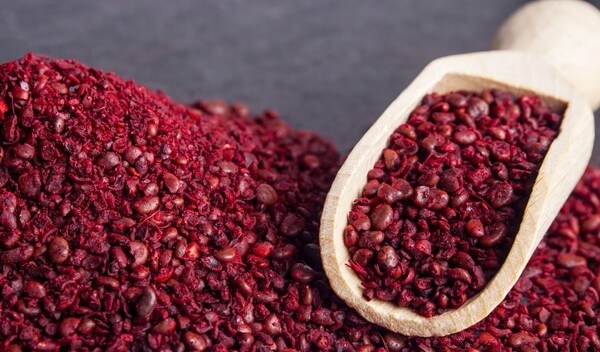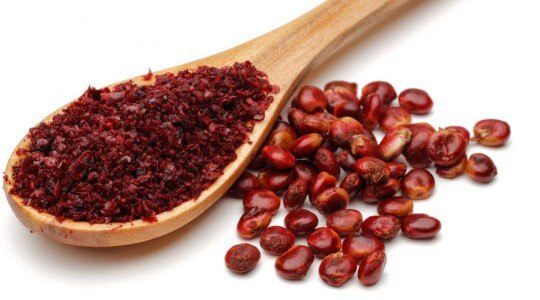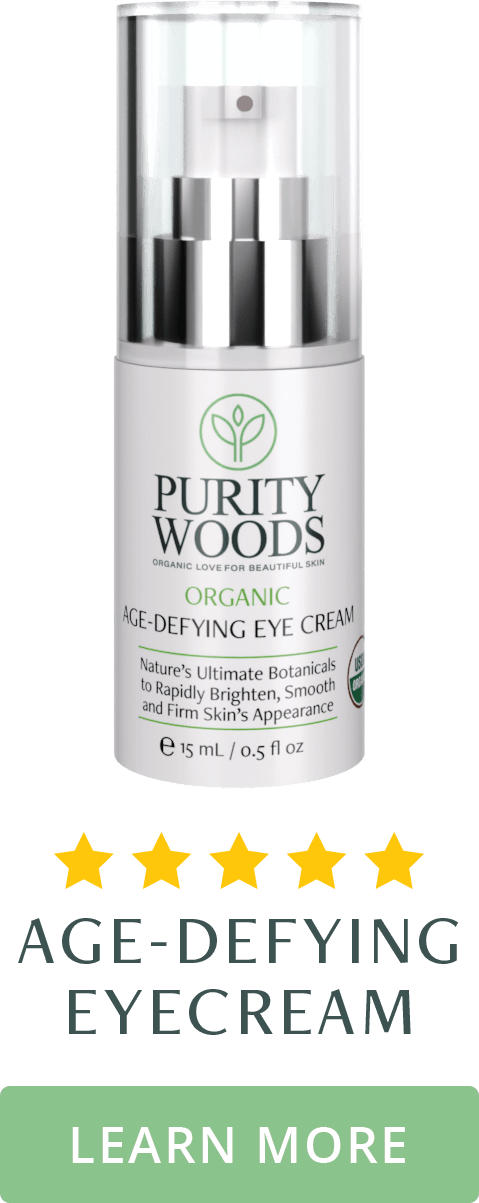Sumac berries are a vibrant red fruit used as a spice in Middle Eastern and Mediterranean cooking. You may have tried them already if you’ve ever used the spice blend za’atar, although they are still working on gaining popularity in the western part of the world.
Like many other herbs and spices, sumac is good for your health as well as for flavoring food. It has some incredible benefits as an antioxidant powerhouse for your skin and boosts inner wellness, too.
Here’s more on the story of sumac berry and why you might want to add it to your skincare routine.
What Is Sumac?
 Sumac is a flowering shrub that grows all over the world. Certain species of it are native to Asia, Africa, and the Mediterranean, while others are found in North America. All belong to the Anacardiaceae plant family, which is the same family cashew and mango trees belong to.
Sumac is a flowering shrub that grows all over the world. Certain species of it are native to Asia, Africa, and the Mediterranean, while others are found in North America. All belong to the Anacardiaceae plant family, which is the same family cashew and mango trees belong to.
There are a few hundred different species of sumac. However, the one most commonly grown for berry harvest is called Rhus coriaria. In the U.S., there are two common species that grow natively: R. glabra and R. typhina.
As you would imagine, sumac berries are the fruit of the trees. They are bright red and grow in clusters that are harvested when ripe. The berries are then dried and ground before being used or sold as the spice called sumac.
If you’ve never tried sumac spice, it has a tart, acidic, and slightly fruity flavor. Many people describe it as lemony (or like a salty lemon zest), although it’s not sour like lemons are.
Traditional Uses for Sumac Spice
Besides being a key spice in Middle Eastern cuisine, sumac also has a history of use in traditional medicine, including by Native Americans.
Sumac spice was mentioned by the Greek physician Dioscorides, which means it has been used for health reasons for at least 2000 years! It was considered an astringent herb (which means it tones tissues in the body) and used as an antiseptic, digestive aid, and general health tonic.
Certain Native American tribes also valued sumac. They would use the fresh berries to make a tart, lemony tea. Though it didn’t contain any lemons, it would later be nicknamed “sumac lemonade” because of the acidic flavor.
The tea could be used to soothe a sore throat, aid digestion, or simply be enjoyed.
Sumac Berries vs. Poison Sumac
If you’ve ever heard of or come into contact with poison sumac, you may be wondering at this point whether it’s the same plant.
The short answer: No, the two are completely different plants- although, they are related.
Sumac and poison sumac do both come from the same plant family- Anacardiaceae. At one point, they even shared the same genus name of Rhus (along with poison ivy and poison oak).
However, because of the confusion surrounding the toxic and non-toxic plants, the botanical name of poison sumac was eventually changed to Toxicodendron vernix to differentiate them.
You don’t really need to worry about the difference between the two unless you’re trying to collect the berries in the wild. In that case, all red-berried species of sumac are considered true species and are edible. Poison sumac looks somewhat similar but has white berries that make it obviously different.
Antioxidant Benefits of Sumac for Skin
 What really sets sumac apart as a skin-boosting spice is its detoxifying antioxidant content, making sumac benefits for skin highly valuable. It’s considered at this point to be the highest antioxidant spice in the world with an ORAC value of 312,400 (blueberries have an ORAC of just 4669 by comparison).
What really sets sumac apart as a skin-boosting spice is its detoxifying antioxidant content, making sumac benefits for skin highly valuable. It’s considered at this point to be the highest antioxidant spice in the world with an ORAC value of 312,400 (blueberries have an ORAC of just 4669 by comparison).
Only a few other edibles, like coffee cherry and astaxanthin, have a higher ORAC value, but sumac is truly the king (or queen) of the spice world.
This antioxidant content means that sumac can be amazing for your skin. That’s because antioxidants are key anti-aging compounds for your complexion as well as your physical health.
Sumac also has antimicrobial properties which means it can kill or slow the growth of microorganisms like bacteria, viruses, and fungi. This property of sumac may be useful for treating or preventing skin infections caused by these microorganisms, including psoriasis, eczema and acne.
The antioxidant content of sumac is especially good for dry skin as it helps fight against free radicals that cause oxidative stress, which can damage skin structure. Sumac also contains anti-inflammatory properties, which can help soothe dry, irritated skin. Therefore, sumac can help promote healthy and clear skin.
Here’s a closer look at what they- and sumac- can do.
Free Radical Fighters
Free radicals are unstable molecules in your body that cause damage to other beneficial molecules. They have an unpaired electron, which makes them react in a destructive way with lipids, proteins, DNA, etc. The damage they cause is known as oxidative stress.
Oxidative stress can affect pretty much any part of your health and body. Lipids and proteins are both key pieces of skin structure, so you can already get an idea of how damaging free radicals are for your skin.
And as you may have guessed, the compounds that help protect your skin from free radicals are none other than antioxidants.
Antioxidants have an extra electron that they can donate to free radicals. This effectively neutralizes the otherwise harmful molecules and helps prevent oxidative stress.
Your skin actually has its own “network” of antioxidants, but unfortunately this gets depleted as you age. That’s why both consuming antioxidant rich foods and applying them to your skin through ingredients like sumac is incredibly important.
Soothes Inflammation
One of the many benefits of antioxidants is their anti-inflammatory power. They are known to lower chronic inflammation within the body that may contribute to disease, but they can also reduce skin inflammation.
Of course, some antioxidants are more powerful for this than others.
Notably, sumac berries contain a specific soothing antioxidant known as quercetin. Quercetin has shown powerful anti-inflammatory properties in studies, including an ability to calm inflammatory skin issues like dermatitis.
This seems to translate to sumac itself, since research indicates that an extract from the berries can prevent skin inflammation.
Protective of Collagen and Elastin
Using antioxidants for your skin is critical for protecting two very important skin proteins: collagen and elastin.

Collagen is the protein that has received the most hype in the skincare world. It makes up around 70% of your skin and helps it stay plump, thick, and firm. When your skin starts losing collagen, wrinkles are able to form more easily and skin looks thinner and looser.
Elastin is an equally important protein that works in concert with collagen. It also helps keep skin firm and young-looking, especially by helping it to “bounce back” after being stressed or stretched. A lack of elastin leads to sagging skin and, of course, more wrinkles.
Both collagen and elastin start degrading somewhere around age 20. A major reason for this is oxidative stress, which induces the enzymes (collagenase and elastase) responsible for breaking down collagen and elastin.
By providing your skin with antioxidants, sumac can decrease oxidative stress and help protect the collagen and elastin already present in your skin. This is one of its key aspects for keeping your skin young-looking.
Protects Against Further Damage
Your skin isn’t necessarily a representation of your physical age. It often looks older than we think it should because of damage done over the years.
Of course, one of the biggest damage dealers is oxidative stress from free radicals. This gets accelerated by many negative factors like environmental pollution, exposure to radiation, toxins in skincare, and so on.
But another big skin-damager is UV radiation from the sun. Too much of it on unprotected skin can cause something known as photodamage, which includes dark spots, wrinkles, loss of elasticity, and uneven tone or texture. Too much UV damage can even affect DNA and is usually difficult to reverse.
Once again, antioxidants are a critical line of defense in this matter. They have major protective properties and have shown themselves particularly protective against UV-induced damage.
Lab studies have even shown that sumac extract has DNA-protective effects, which means it could help your skin at the deepest level.
Slows Skin Aging
The individual benefits of the antioxidants in sumac lead up to one main thing: more youthful looking skin for longer.

Boosts Collagen Production
One of the most outstanding aspects of vitamin C for your skin is that it boosts collagen production. While other antioxidants are important for protecting existing collagen, this special vitamin actually promotes collagen synthesis, helping your body make more of it.
This means that you aren’t stuck with the amount of collagen you have right now. Your skin has the ability to reverse low collagen levels, but it needs a catalyst like vitamin C.
By promoting collagen production, you can actually start reducing visible signs of aging, including wrinkles.
And in case you’re wondering whether sumac has this property, at least one study has shown that it can improve collagen deposition and even enhance wound healing (great news for damaged skin).
Brightens Skin & Reduces Hyperpigmentation
If you’ve ever tried a vitamin C serum, you may have noticed that it had a brightening effect on your skin. That’s because vitamin C can boost a dull complexion and help restore that “glow” to skin.
It’s especially beneficial for hyperpigmentation- a typically age-related condition in which certain spots of skin are darker than the rest of your skin. (This includes age spots, also known as dark spots or sun spots.)
Research has shown that vitamin C can both protect against hyperpigmentation by impeding melanin formation and reduce the appearance of existing pigmentation. Applying it regularly will help those age spots to start fading away.
Evens Out Skin Tone
Red or irritated patches of skin can show up as a result of damage over the years. Or you may have spots that look dull or have a different texture than the rest of your skin.
Vitamin C is excellent for evening out skin tone and lessening the appearance of redness or irritation because of its anti-inflammatory action. It also helps to rejuvenate skin, which will make your complexion look less dull and more bright and healthy.
Other Potential Benefits of Sumac Berry
 While sumac obviously has a lot of anti-aging power for skin, it also has some other potential health benefits. Here’s a quick look at how it may be able to boost your physical health:
While sumac obviously has a lot of anti-aging power for skin, it also has some other potential health benefits. Here’s a quick look at how it may be able to boost your physical health:
- May Regulate Blood Sugar– Some research has shown that sumac can reduce blood sugar levels in diabetic patients. It also led to better overall blood sugar control over a period of three months. Another study showed that it could improve insulin resistance, which may be more good news for diabetics.
- May Reduce Inflammation and Disease Risk– Because of its incredibly high antioxidant content, sumac can likely help to reduce chronic inflammation and may also lower your risk of diseases related to oxidative stress. Sumac specifically hasn’t been studied in this capacity, but much research shows these benefits for antioxidants in general.
- May Ease Muscle Pain– One study from 2016 found that sumac juice was able to reduce muscle pain during aerobic exercise. This was only one small study, but it will be interesting to see whether new research finds more pain-relieving benefits of sumac.
Using Sumac Berry for Your Skin
To get the most out of sumac, the best method is to apply it topically.
Your skin will also get the benefits of the antioxidants and vitamin C in sumac if you consume it, but it’s difficult to take enough of it to make a difference. Simply using sumac as a spice means you’re getting very minimal amounts. It may be more concentrated as a juice or if you use the berries to make a tea, but both of these forms of sumac are hard to come by.
To make it easy on yourself, look for a skincare product that features this fairly new ingredient.
Sumac for Youthful-Looking Eyes
 The Age-Defying Eye Cream from Purity Woods is one of very few skincare products that are making use of the powerful antioxidant content of sumac berries. It contains pure, organic sumac berry extract along with 20+ other botanicals that are formulated specifically for the delicate skin around your eyes.
The Age-Defying Eye Cream from Purity Woods is one of very few skincare products that are making use of the powerful antioxidant content of sumac berries. It contains pure, organic sumac berry extract along with 20+ other botanicals that are formulated specifically for the delicate skin around your eyes.
Packed full of antioxidants and natural moisturizers, this eye cream effectively fades the appearance of wrinkles, dark circles, under-eye bags, and sagging skin using only the power of plants.
The entire formula is 100% USDA Certified Organic and contains zero unpronounceable ingredients (unless you count the Latin names of all the organic plant extracts).
Learn more about the Age-Defying Eye Cream here and start boosting your skin with sumac berry!





